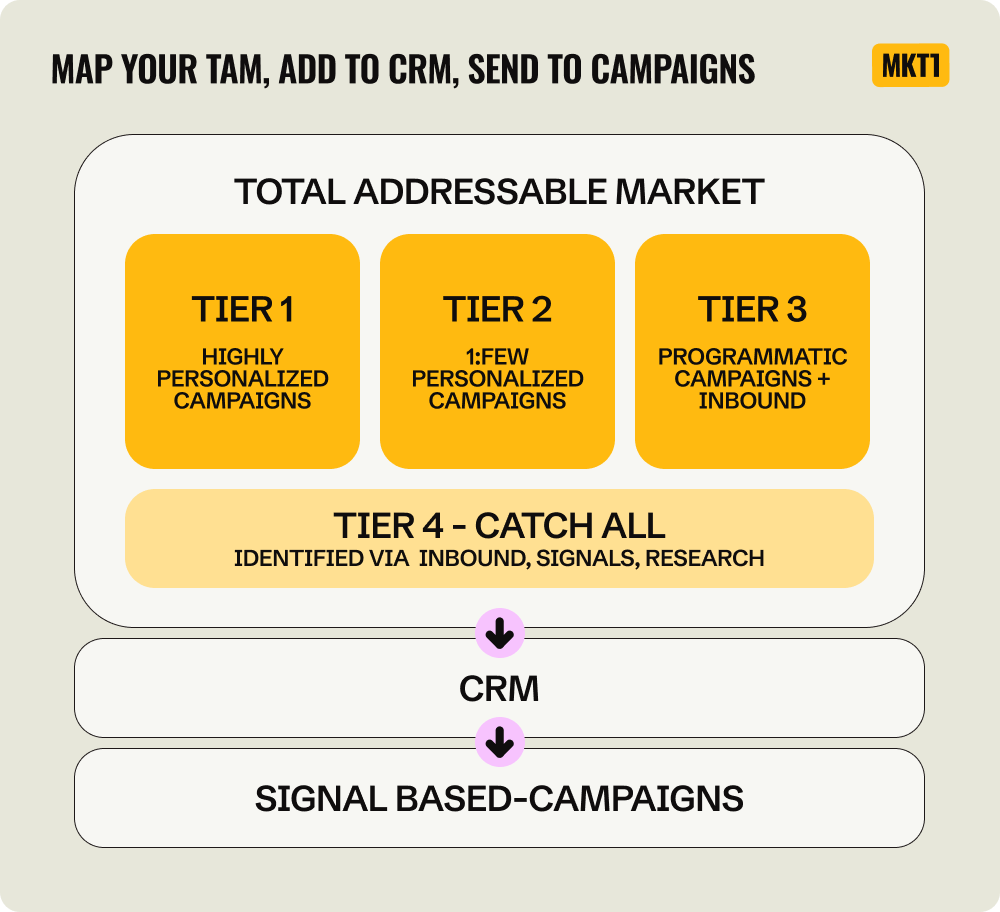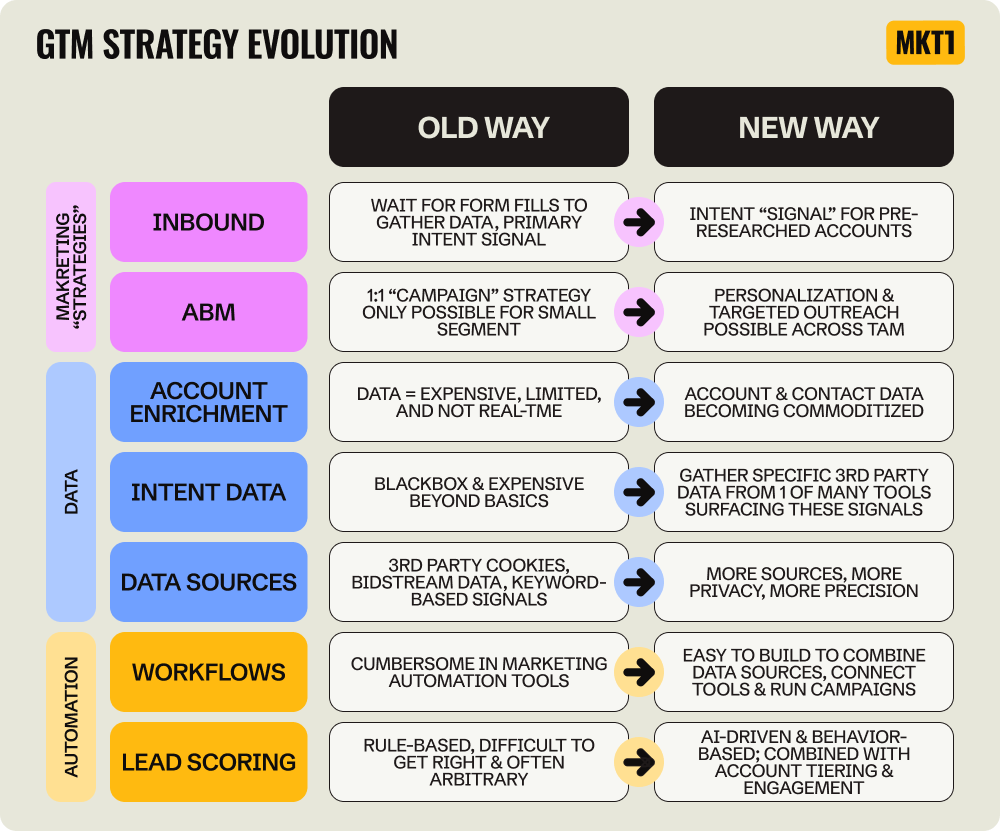The Shift to Account-Driven GTM
Part 1 of 3: Why traditional inbound & ABM are no longer enough to win
👋 This is a monthly free edition of MKT1 Newsletter—a deep dive into a B2B startup marketing topic. This edition is brought to you by Attio, Ten Speed, and Omni Lab. Become a paid subscriber to receive an additional newsletters each month, access our archives, post to our job board, and access our template library.
There’s no excuse to wait for all of your prospects to come inbound anymore. In fact, it’s probably careless to do this.
It used to be too expensive—both in terms of time and money—to map your entire total addressable market (TAM) into your CRM. This is no longer true. It is now possible for even a marketing team of one to map their TAM, enrich their priority accounts, and create content and campaigns tailored to these accounts.
This means personalized outreach and a unified marketing and sales approach no longer needs to be reserved for the ~100 accounts on your “ABM” list. Plus, inbound no longer needs to be your primary way to collect contact info or gauge intent. Instead, it’s just one of many signals that help you identify the right accounts to focus on.
Your marketing strategy needs to shift to a more account-driven approach, but that does NOT mean you should:
Identify every company in the universe and SPAM them with outbound
Apply the same ABM strategies you previously reserved for a shortlist of accounts to everyone in your TAM
Stop making valuable content that attracts people to your website
But, I am suggesting you rethink some things when it comes to your go-to-market (GTM) strategy…
In this newsletter:
This newsletter is part one of a three-part series. Subscribe so you don’t miss parts 2 and 3.
Why your GTM strategy needs to shift: Tech and data improvements making an account-driven approach necessary
What is an account-driven GTM strategy?: How it differs from ABM, ABX, and traditional inbound
Implementing this strategy: A summary of how to map your TAM, define tiers, track intent signals, run account-driven campaigns, and measure success.
Part 2: Deep dive into the set up and foundation required for an account-driven GTM strategy
Part 3: Deep dive into running signal-based campaigns
Paid subscribers resources: Account-driven signal list, 50+ signal-based campaign ideas, and account tiering methods available now in our template library.
Recommended products & agencies
We only include sponsors we’d recommend personally to our community. If you are interested in sponsoring our newsletter, email us at sponsorships@mkt1.co.
Attio is the next-generation CRM. It has built-in AI agents and powerful workflows, so you can take the right actions on your leads automatically. And it syncs with your email and calendar so you can start using it right away.
🎁 Offer: MKT1 subscribers get 15% off your first year.
Ten Speed partners with startups (including my advisees) on organic growth, full-service SEO & content marketing. They recognize that growth isn’t one-size-fits-all and build plans specific to your goals & ICPs.
🎁 Offer: Mention MKT1 to get $1,000 off your first month.
Omni Lab helps growth-stage startups scale their paid media & demand gen strategy. They focus on building a full-funnel strategy across ad channels, while helping you with ad creative and tracking to drive opportunities and revenue.
🎁 Offer: Get a $2500 paid media assessment for FREE - available to the first 10 qualified MKT1 subscribers here.
Complete list of discounts available here for paid subscribers, with more coming soon!
Dear Marketers, I have a new podcast
Last week, I launched Dear Marketers with Emily Kramer & Friends. New episodes will be out every 2 weeks on Spotify, Apple Podcasts & YouTube—and here on Substack with a companion newsletter.
Each episode, my co-hosts, friends, and former Asana marketing teammates, Grace Erickson, Jenny Thai, and Devon Watts answer a question submitted by an MKT1 community member. If you like this newsletter, I think you’ll love this podcast.
What’s behind this seismic GTM strategy shift?
4 factors are driving the change:
If you're on LinkedIn, you've probably seen these trends everywhere, but I’ll recap to show how when combined they’re driving a fundamental shift in GTM.
Ease of mapping your TAM: It’s now possible to research your entire audience, meaning all the companies who you could potentially sell to, and add them into your CRM. And it’s possible to do this at a level-of-detail previously reserved for your tiny ABM list of top tier accounts.
More data & signals: You can automatically enrich those accounts and contacts with a lot more data. From basic demographic and firmographic data, to engagement with your content, to 2nd and 3rd party signals, you can get a much clearer picture of where each account stands and how much effort you should be putting into each one.
Account & contact-specific marketing tactics: Reaching each account and contact through the right channel with personalized, tailored content is now possible at a larger scale. You can craft “bespoke” campaigns for individual accounts or segments, and when done well, this improves both efficiency and effectiveness.
Unification of GTM teams: Due to reasons 1-3, plus the focus on tighter budgets and growth efficiency over the past couple of years, GTM teams are collaborating more closely. I include marketing, sales, rev ops, and customer success in “GTM teams.”
I’m calling this account-driven GTM strategy…
Account-driven GTM involves more than just expanding ABM, redefining inbound’s role, and unifying your GTM teams (marketing, sales, CS). It requires a fundamental change to how marketing works, from how you are set up on the ops and analytics side to how you execute campaigns and create content.
How is this different than ABM or ABX?
You may have seen what I’m describing called ABM 2.0, ABX, or “ABM everything.” Is this the same as what I’m talking about? Not exactly.
While I do love an acronym, all the buzzwords are adding to the confusion. As a B2B marketer in 2025, it’s actually really important to understand that your “tried and true” go-to-market strategy itself needs an upgrade.
That’s why I’m using the term "account-driven GTM strategy" to describe this new approach—at least until something better comes along. This phrasing avoids the baggage of “account-based”. And while not every marketing activity you do will be 100% account-based, your entire GTM strategy should be built on top an account-driven foundation.
More from MKT1
📖 Keep reading: Paid subscribers get access to the rest of this newsletter—definitions of ABM vs. ABX, who should shift to account-driven GTM, and how to implement account-driven GTM at your company.
✂️ Templates and discounts for paid subscribers: Paid subscribers can find all growth marketing templates here including an account-driven signal list, 50+ signal-based campaign ideas, and account tiering methods. Active discounts on products we recommend.
👁️ Related newsletters: Anatomy of a marketing plan, How to set up account-driven GTM, and Guide to signal-based campaigns
🧑🚀 Job board: Jobs from the MKT1 community. Paid subscribers can now add jobs to our job board for free.






